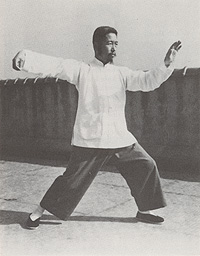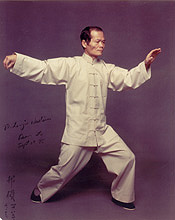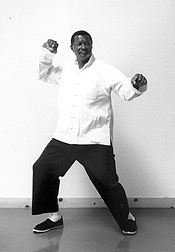Professor Cheng Man Ch’ing’s “Short” Yang-style Form
The style of Tai Chi practiced at the Tai Chi Berkeley school is a shortened Yang-family form developed by Professor Cheng Man Ch’ing, who learned the art of Tai Chi from Yang family master Yang Cheng-fu. The form – currently practiced throughout China, the U.S., Europe, and Australia – is a sequence of several dozen precisely choreographed postures, which are normally performed in approximately 10-12 minutes.
School Philosophy
Instructor Lenzie Williams writes, “Tai Chi is such an incredibly multi-faceted art and diverse art form, with many areas of potential development. This school represents an environment where people are carefully taught the important basics and fundamentals of the art, then are encouraged and supported in working at whatever level and pace they choose (some students stay in the beginning class for two years, as I did with my teacher, or even longer). Individuals working with health, rehabilitation, and healing issues will find much improvement. Those needing to get in touch with their bodies, to get more grounded and centered, and to cultivate relaxation as an antidote to stress will find much benefit from this practice. For those seeking their development through the Way of Wu Shu (martial training) and Wu Te (martial virtue and philosophy), Tai Chi Berkeley is a safe and cooperative, yet a challenging and developmentally rich, arena in which to cultivate this aspect of the Art. Perhaps most importantly, the school offers a Way, a Path, an Approach to a very unique process of development of Body, Heart, Mind, and Spirit. This school holds the Context in which we come together as individuals on our unique journeys to work as a group (synergy Principle) through the Art of Tai Chi Chuan, to contribute to our classmates’ development and our own Self-Cultivation, thereby allowing us to actualize the best and most of our potential as human beings.”
History of Tai Chi
There are numerous and varied stories of the origin of Tai Chi Chuan. The most likely origins are several important individuals (Chang San-Feng is mentioned most frequently); the development of various yogic, martial, and military art systems; and knowledge and wisdom from the Chinese medical and healing systems, such as the Nei Ching (the Yellow Emperor’s Classic of internal medicine) and other medical treatises. Last but not least were the important philosophical teachings of China, such as the I Ching, and important influences from Taoist texts such as the Tao Te Ching. These influences all came together to produce the internal Martial and Healing art we have come to know as Tai Chi Chuan.
School Lineage
Yang Lu-Ch’an was responsible for developing the Yang style of Tai Chi Chuan, after studying with Chen Chiang-hsiang. Yang Lu-Ch’an, known as “Yang the Unsurpassed” (in reference to his extraordinary martial skill) passed his knowledge on to his two sons, Chein-hou and Pan-hou. Chien-hou then taught the art to his two sons, Shao-hou and Cheng-fu. Yang Cheng-fu in turn passed his knowledge to a few close students, one of whom was Cheng Man-Ch’ing. Cheng Man-Ch’ing passed the art to several disciples. One of the most notable of these disciples is Lo Pang Jeng (Mr. Ben Lo), who has taught this system to thousands in the United States, Europe, and Taiwan. Mr. Lo has several Senior students, one of whom is Lenzie Williams, the instructor at Tai Chi Berkeley.
Laoshi Lo was born in China and moved to Taiwan in 1948. His initial relationship with Professor Cheng Man-Ch’ing was as a patient. Professor Cheng, a singularly unique individual, was known as a “Master of Five Excellencies,” revered as a doctor of Chinese medicine, a poet, a calligrapher, a painter, and a master of Tai Chi Chuan. Laoshi Lo soon began to study Tai Chi Chuan with Professor Cheng, and in a few years became one of his top students. With exceptional Tai Chi skills, Laoshi Lo remained among the foremost teachers and practitioners in Professor Cheng Man Ch’ing’s lineage until his death in 2018, at age 91. Besides his extraordinary skills as a practitioner of the art, his impact as a teacher was widespread and profound. His teaching offered the rich legacy and tradition of the past to students here, today. With great integrity, he maintained the vital legacy of his teacher, and required the same of his teaching students. While adhering to the traditional qualities and essential nature of the art taught by Professor Cheng, Laoshi Lo exhibited in his own person and in his teaching two of the most important qualities of Tai Chi: adaptability and change. The impact of Laoshi Lo and his teaching profoundly transformed Tai Chi Berkeley instructor Lenzie Williams, who assumes responsibility to pass on his teacher’s Art as an honor and a privilege.
Instruction at Tai Chi Berkeley
Beginning, Intermediate, and Advanced level classes are offered by Lenzie Williams, with the assistance of his senior students. Please check the Class Schedule page for details.


